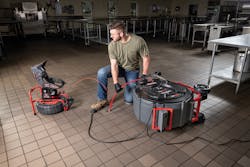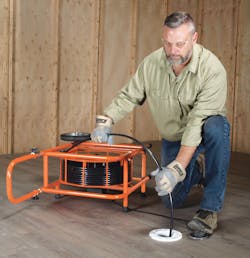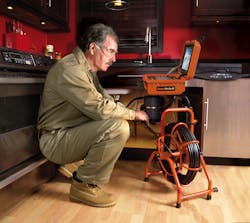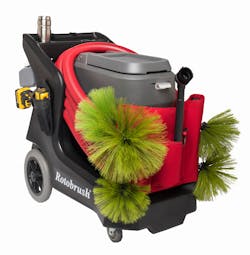There’s an old saying: “Don’t put all your eggs into one basket.” It’s something most of us take to heart when investing in our company’s 401(k) or in an individual retirement account. We are encouraged to put investment eggs (dollars) into several different baskets (from safe investments to ones that are riskier).
That same philosophy works in the business realm. While there are companies that thrive on providing one type of product or service, many others find success by adding something new and excelling at it.
“Since the private sector is unpredictable at best, and customer whims are notoriously fickle, it can pay to broaden your company's horizons and pursue new opportunities—no matter how confident you may be in your existing offerings,” writes William Craig in a Forbes article (https://bit.ly/3jnV4VO). “But diversification is not a cure-all for the struggling business, nor a sure way to cement your lead if you're already thriving. [However,] it's one potential answer if you want to remain competitive.”
The Corporate Finance Institute defines three diversification types (https://bit.ly/2WuxNss):
1. Concentric diversification: Adding similar products or services to the existing business.
2. Horizontal diversification: Providing new and unrelated products or services to existing consumers.
3. Conglomerate diversification: Adding new products or services that are significantly unrelated and with no technological or commercial similarities. This is the riskiest proposition.
Let’s talk about concentric diversification, the low-hanging fruit, in the plumbing and heating contracting services business. Two services come to mind that can be easily incorporated into such firms: drain cleaning and air duct cleaning.
Drain cleaning: A recession-proof business
“Ask any plumbing contractor if drain cleaning is important,” notes Marty Silverman, vice president of marketing at General Pipe Cleaners. “Ask them if it’s a growth industry. They’ll tell you that that they have never been so busy since COVID-19 started and homeowners have shoved everything imaginable down the drain. Drain cleaning is a career everyone should get into. No matter what the economy, no matter what season, drains clog. It’s a recession-proof business.”
Jeff Albertini, director of marketing, underground technologies for Ridgid, agrees, noting that the pandemic opened up new revenue streams for customers: “One of the best reasons drain cleaning is a fantastic add to plumbing companies is drains clog regardless of what’s happening with the economy. Even in tougher economic times, the need for drains to be cleaned remains the same and keeps plumbers and drain cleaners’ schedules full of work.
He adds that drain cleaning is a good add-on “since most of the world has existing infrastructure in place for many years. The aging infrastructure keeps a plethora of work available across the entire globe for a variety of drain-cleaning opportunities.”
Plumbers do not need any certification or licensing to add drain-cleaning services to their repertoire. However, it is recommended that they are trained in the proper use of the brand of equipment they choose, as well as the personal protective equipment needed to keep technicians and customers safe.
“Instructional videos show you how to use the machine in terms of turning it on and plugging it in, etc.,” Silverman notes. “But to get a feel for what's down the line, what kind of stoppage, and how best to clear it, it comes from experience.”
Ridgid and General Pipe offer product training to end-users in different forms.
General Pipe also offers many instructional videos for its products, but customer service is where plumbers can get the best help.
“Our customer service staff, the Drain Brains, collectively have more than 200 years of experience,” Silverman says. “They are happy to assist with advice on any questions and guidance for a new contactor. We also have many experienced contractors we can call for an opinion if needed.”
As plumbers add this new service, they can rent equipment rather than buying it outright. “Whether renting from other plumbing companies or from a commercial business such as a local home center, it is important to get a good understanding of what the equipment can do,” Albertini explains. “We recommend reading manuals and watching videos to learn about the equipment prior to using it.”
General Pipe manufactures a full line of machinery for the rental industry. “Small plumbing and drain cleaning businesses understand the economic advantages of renting costly drain cleaning and inspection equipment,” Silverman notes. “That’s why we partner with the rental industry in providing reliable drain cleaning and inspection solutions that help small businesses get on their feet—and maximize profitability.”
Additional advice includes:
1. Safety first, Silverman says: “Contractors should always wear leather gloves with handling a spinning cable. Wear eye protection to protect against spray and debris. Check the electrical cords for cuts or frays. Insist on a pneumatic foot pedal control to keep hands free to feed and guide cable. And make sure the outlet is properly grounded. And most importantly, use common sense.”
2. Thorough inspection. Both companies offer high-tech inspection cameras and monitors that allow plumbers to see what the problem is and where it is located before any drain-cleaning equipment is used.
3. Understand your market, Albertini says: “What are other companies doing today to solve these problems in your area and what can you and your business do differently to drive growth and build reputations as a reputable drain-cleaning company?”
4. Understand your numbers. “Like any business, you need to have a good understanding of your financials to accurately price out work and ensure profitability,” Albertini explains. “It is important to understand costs associated with your products like servicing and replacing wearable items that can impact your bottom line if not properly accounted for."
5. Choose the right products. Both stressed the need for research before committing to a drain-cleaning brand. Look for reputable manufacturers; newer, smaller companies may be less expensive, but they may not be around in five or 10 years.
6. Attend conventions and trade shows, join industry associations. WWETT is the biggest trade show for drain- and sewer-cleaning services; it is usually held in Indianapolis each year. Plumbing contractors can find a lot of information on branded equipment.
“The more valuable part of those shows is to talk to other contractors, and people are generally very willing to help each other,” Silverman notes. “They're usually from other cities, and over a beer at the cocktail hour, they talk about the products they like and how they solve a particular clogged drain problem.”
Albertini agrees networking is essential: “From a networking standpoint, there are multiple forums and social media groups geared towards this industry. Reaching out to other individuals that have this capability or are thinking about adding this service can help build confidence and help you fully vet out your decision to expand your business.”
Duct cleaning in the age of COVID-19
“Back five or seven years ago, heating and air contractors never even wanted to get into duct cleaning,” notes John Kovacs, vice president of sales with Rotobrush International. “But it was something that they were almost forced to do because their customers were continuously calling them and asking for it.
“When it comes to COVID, we have seen such an increase in duct cleaning; the response has, at a bare minimum, doubled. It is just unreal. And not just from new contractors adding it but from contractors that already offer it; our customers who already offer the service are coming back to get their second, third, fourth or fifth machine. The consumer awareness has never been greater.”
Duct cleaning also does not require any certification or licensing, but Rotobrush offers a one-day manufacturer certification class: half the day covers sales and marketing, the other half is devoted to hands-on training. The pandemic put a halt to that training, but Kovacs says it should be starting up again soon.
“The class isn't necessarily designed to teach you how to clean ducts,” he explains. “It's designed to show you how to be more effective to get on and off of a job just that much faster, being more efficient with it.”
He adds that contractors cannot rent duct-cleaning equipment. After purchasing equipment, new customers receive training, instructional manuals and videos. In lieu of in-person classes, Rotobrush offers Zoom classes every day through its customer service department to walk customers and potential customers through the sales/marketing/product training normally covered in those face-to-face classes.
“The one thing contractors need to understand about duct cleaning is it's not just duct cleaning,” he explains. “If they're going to bring it onto their business, it’s because their customers are asking for it. Once they have the ducts cleaned, the first thing customers want to know is how to keep them clean. Well, there's no way to keep them clean, so the next step is proper filtration.”
As with drain cleaning, video inspection is an essential activity for success. Most homeowners will approve the duct cleaning once they see what’s in them—especially people who have severe allergies or asthma. And, of course, anyone who has COVID-19 concerns.
“The key to duct cleaning is making sure that you have a video inspection system that you're using simultaneously with the cleaning,” Kovacs says. “We can't stick our head down a 35-ft. pipe that has a 6-in. diameter and know if it's clean on the other side. Validate the need for it. Validate that you did exactly what you said you were going to do as far as cleaning it.”
Kovacs echoes the advice of Albertini and Silverman regarding safety, financials and networking. And it comes down to proper training for technicians.
“If you're not cleaning the ducts properly, then you're not helping anyone,” he says.
Kelly Faloon is a contributing writer to Contractor magazine and principal of Faloon Editorial Services. The former editor of Plumbing & Mechanical magazine has more than 20 years of experience in the plumbing and heating industry and B2B publishing. She is a journalism graduate of Michigan State University.
About the Author

Kelly L. Faloon
Freelance Writer/Editor
Kelly L. Faloon is a contributing editor and writer to CONTRACTOR, Contracting Business magazine and HPAC Engineering and principal of Faloon Editorial Services. The former editor of Plumbing & Mechanical magazine, Faloon has more than 26 years of experience in the plumbing and heating industry and more than 35 years in B2B publishing. She started a freelance writing and editing business in 2017, where she has a varied clientele.
Faloon spent 3 1/2 years at Supply House Times before joining the Plumbing & Mechanical staff in 2001. Previously, she spent nearly 10 years at CCH/Wolters Kluwer, a publishing firm specializing in business and tax law, where she wore many hats — proofreader, writer/editor for a daily tax publication, and Internal Revenue Code editor.
A native of Michigan’s northern Lower Peninsula, Faloon is a journalism graduate of Michigan State University. You can reach her at [email protected].




